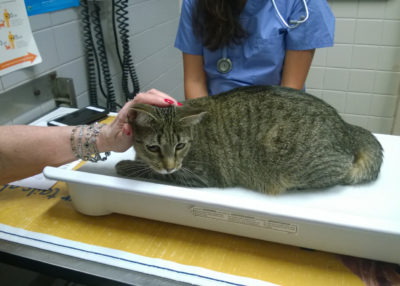Pancreatitis in Cats: Causes, Signs, and Treatment

Pancreatitis in Cats: Causes, Signs, and Treatment
June is Adopt-a-Cat Month. For the entire month, I’m devoting my blog posts to issues important to feline families. Today’s blog post will focus on a poorly understood disease: feline pancreatitis.
Pancreatitis defined
Any disorder ending in –itis refers to inflammation. For example, tonsillitis is inflammation of the tonsils. So pancreatitis means inflammation of the pancreas. Pancreatitis may be more common in dogs than in cats, in part due to the indiscriminate eating behavior of dogs. Pancreatitis can be acute, meaning a sudden and severe onset, or chronic. Chronic pancreatitis is more difficult to identify since the signs are milder than acute pancreatitis. Some cats with chronic pancreatitis often exhibit waxing and waning signs.
Causes of pancreatitis
According to a recent study in the Journal of Veterinary Internal Medicine, the cause of pancreatitis was unknown in the vast majority of feline patients. When the cause was identifiable (only about 15% of cases), the causes were general anesthesia, trauma, low blood pressure and insecticide of the organophosphate class. This lack of clarity regarding the cause of pancreatitis means veterinarians can’t make recommendations to feline families on home care steps to prevent this disease.
Clinical signs of pancreatitis
In my mind, most cat diseases look the same clinically. Pancreatitis is no exception. Clinical signs of feline pancreatitis include poor appetite, lack of energy, vomiting, diarrhea and yellow colored skin known as jaundice. This same description could apply to liver disease, intestinal disease or feline infectious peritonitis. The clinical similarities between many feline diseases explain why a battery of blood tests and diagnostic imaging are required to confirm a diagnosis of pancreatitis.
The triad – pancreatitis, hepatitis, and inflammatory bowel disease
Pancreatitis is but one side of a medical triad of diseases that frequently occur together. The other two diseases are hepatitis (inflammation of the liver) and inflammatory bowel disease. Understanding the “plumbing” system of these three organ systems explains why the triad occurs. The liver and pancreas share a common duct which supplies digestive enzymes and bile to the intestine. Some veterinarians hypothesize that an infection in one of these organs can easily spread to the other two via the shared duct system.
Treatment of pancreatitis
Cats with pancreatitis feel lousy and making them feel better requires many different medications. Those with acute pancreatitis may need to be hospitalized if vomiting and a poor appetite leave them dehydrated. Pancreatitis can also cause abdominal pain. Hospitalization may be necessary to administer pain medication and antibiotics by injection if vomiting prevents oral administration.
Cats with concurrent inflammatory bowel disease may also receive steroids. If appetite stimulants don’t improve your cat’s food intake, a feeding tube may be necessary to provide adequate nutrition. Feeding tubes also make medicating your cat a breeze. I hope this blog post provides some helpful information to clear up any questions about feline pancreatitis.






























